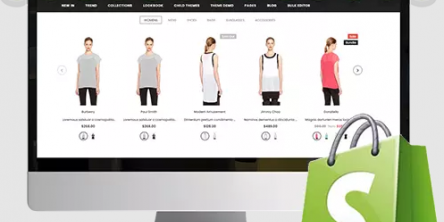5 Tips for a Smooth Move From Shoplazza to Shopify

In e-commerce management, Shoplazza stands out for its user-friendly interface. Many Shoplazza reviewers also praise the website’s slew of customizable templates and its fairly robust marketing features and customer management tools.
However, Shoplazza has received multiple thumbs-downs for its lack of advanced features. And while relatively easy to navigate, many beginners often have to contend with a steep learning curve. Due to those limitations, Shoplazza clients are migrating to Shopify in droves.
Shopify provides all of Shoplazza’s standout features, plus much more. From an intuitive dashboard to a vast collection of customizable templates, advanced SEO tools, and diverse pricing plans….Shopify has everything you’d want in an e-commerce management service.
This article highlights the top five things to remember while migrating from Shoplazza to Shopify.
Photo Credit: Pixabay.com
Why Migrate To Shopify?
Before we explore the tips for a seamless migration from Shoplazza to Shopify, it’s important to understand the significance of the transition.
Shopify boasts numerous features that make it the first port of call for many online entrepreneurs.
First off, the platform is remarkably user-friendly. It was developed with the average, non-techy user in mind. You can quickly migrate your Shoplazza products, product categories, and other useful information using Shopify’s drag-and-drop functionality.
Enhanced scalability is another compelling argument in favor of migrating from Shoplazza to Shopify. Shopify has pricing plans for every business type and growth stage. Start with the basic plan if you are taking your initial steps into the world of e-commerce. As your business scales newer heights, you can unlock more salient store management features by upgrading to enterprise-level packages.
Below are other noteworthy benefits of Shopify over Shoplazza.
1. Improved Security
Shopify implements robust cybersecurity protocols to safeguard your store’s critical information. All pricing plans include PCI compliance to secure credit card transactions. Besides, the integration of two-factor authentication (2FA) into the checkout process provides an extra layer of security by flagging potentially fraudulent transactions.
2. Enhanced SEO Tools
The success of e-commerce businesses is largely predicated on the implemented SEO strategies.
Fortunately, Shopify provides a slew of free and premium SEO services, including technical SEO audits to ensure your website is on course with its SEO objectives.
3. 24/7 Customer Support
Shopify’s customer support is available round the clock to address your store-related queries as and when you raise them. The company works with professionally trained customer care agents who prioritize solving their clients’ needs.
Photo Credit: Pixabay.com
Tips for Migrating From Shoplazza to Shopify
1. Choose a Proper Migration Tool
There are various ways to migrate from Shoplazza to Shopify, including;
-
Manual migration using a Comma Separated Value (CSV) file
-
Utilizing a website migration application
-
Hiring a professional website migration service
The last option is preferable, as it offers a higher degree of automation.
However, not all website migration services are similar. To pick the right provider, consider your budget and the data you need to transfer.
Other critical considerations include an uptime guarantee and enhanced data protection.
2. Gather the Requisite Resources
Website migration is inherently resource-intensive. As such, you want to allocate sufficient resources ahead of time.
Factors like your business size, volume of the data to transfer, and the selected migration service will determine the amount of resources to set aside.
Be sure also to make some contingency allocations. This is necessary in the unfortunate event of unforeseen downtimes caused by accidental data loss or system performance issues.
Photo Credit: Pixabay.com
3. Assess Your Current Shoplazza Account
It’s prudent to thoroughly analyze your current Shoplazza store to identify the type of data to migrate to Shopify. Commonly transferred information includes product details, customer accounts, orders (both current and historical), marketing content (such as blogs), and SEO analytics tools.
Examining your Shoplazza account also lets you evaluate the platform’s performance. That way, you can identify the features to enhance and those to introduce when you finally move to Shopify.
Besides, take the opportunity to update any old content and organize your data into supported file formats.
4. Back Up Your Shoplazza Data
Accidental data loss is one of the biggest pitfalls when migrating from Shoplazza to Shopify.
To prevent these unpleasant surprises and their costly repercussions, consider backing up your Shoplazza data.
Transfer all your current Shoplazza information to local hard disks, as well as to cloud storage services. This ensures you have a fallback plan if the data gets lost or corrupted during the transition phase.
5. Test and Optimize Your Shopify Account
After backing up your Shoplazza data and finally migrating to Shopify, the next logical step is to test your new Shopify platform.
Initial tests help to confirm that Shoplazza data was successfully transferred and all features on the new platform are operating optimally.
Working with an experienced website migration service can streamline the testing and optimization by evaluating your website across different devices, browsers, and operating systems.
Photo Credit: Pixabay.com
Final Word
Migrating from Shoplazza to Shopify lets you unlock Shopify’s slew of nifty e-commerce management solutions while maintaining your critical Shoplazza data. However, as you may have gathered, a seamless migration from Shoplazza to Shopify is only possible with a professional website migration tool.
Research extensively to find a migration service that guarantees maximum uptime and data protection during the transition period. The company must also support the transfer of multiple datasets, helping you replicate or recreate related Shoplazza categories in Shopify.
Needless to say, set aside adequate resources required for a smooth Shoplazza to Shopify migration.
Similar Articles
The rapid growth in the eCommerce sector has been reshaping the way businesses work and relate to their customers. Under this, companies are experiencing vast pressure to craft incredible customer experiences with an efficient scale as global sales of eCommerce will reach $8 trillion by 2027.
Starting a business is now very popular because we live in a world that is full of modern technologies and business models, opening unlimited possibilities and significantly increasing profit.
Merchants' key retail objective is to claim the Buy Box on a popular marketplace. This sought-after spot, featured prominently on product pages, frequently boosts sales. Attaining the buy box position requires navigating pricing tactics, seller evaluations, and delivery approaches
To run a successful marketing campaign you want to assess your prospects interests based on their engagement level. You want to know who the hottest leads are. It’s those leads who you want to email with your offers
Discover how an online store can expand your local business globally by reaching new markets, increasing sales, and leveraging e-commerce strategies effectively.
In today's fast-paced digital landscape, succeeding in ecommerce requires more than just having a great product and a functional website. With millions of online stores vying for attention, standing out from the crowd demands strategic planning and execution.
At this point, e-commerce is practically omnipresent. Think about it — e-commerce is present in various sectors already, helping people and businesses buy a wide variety of products and services through some clicks of a mouse. But what keeps such e-commerce businesses running in the face of such intense requirements?
For businesses to thrive in the dynamic world of e-commerce, staying ahead of the competition is essential. And therefore, delivery of exceptional customer experiences has become paramount for everyone – from small startups to established enterprises
E-commerce businesses are facing challenges to stay competitive. This is where you need the Shopify application. Read on to learn about the Shopify app guide.









